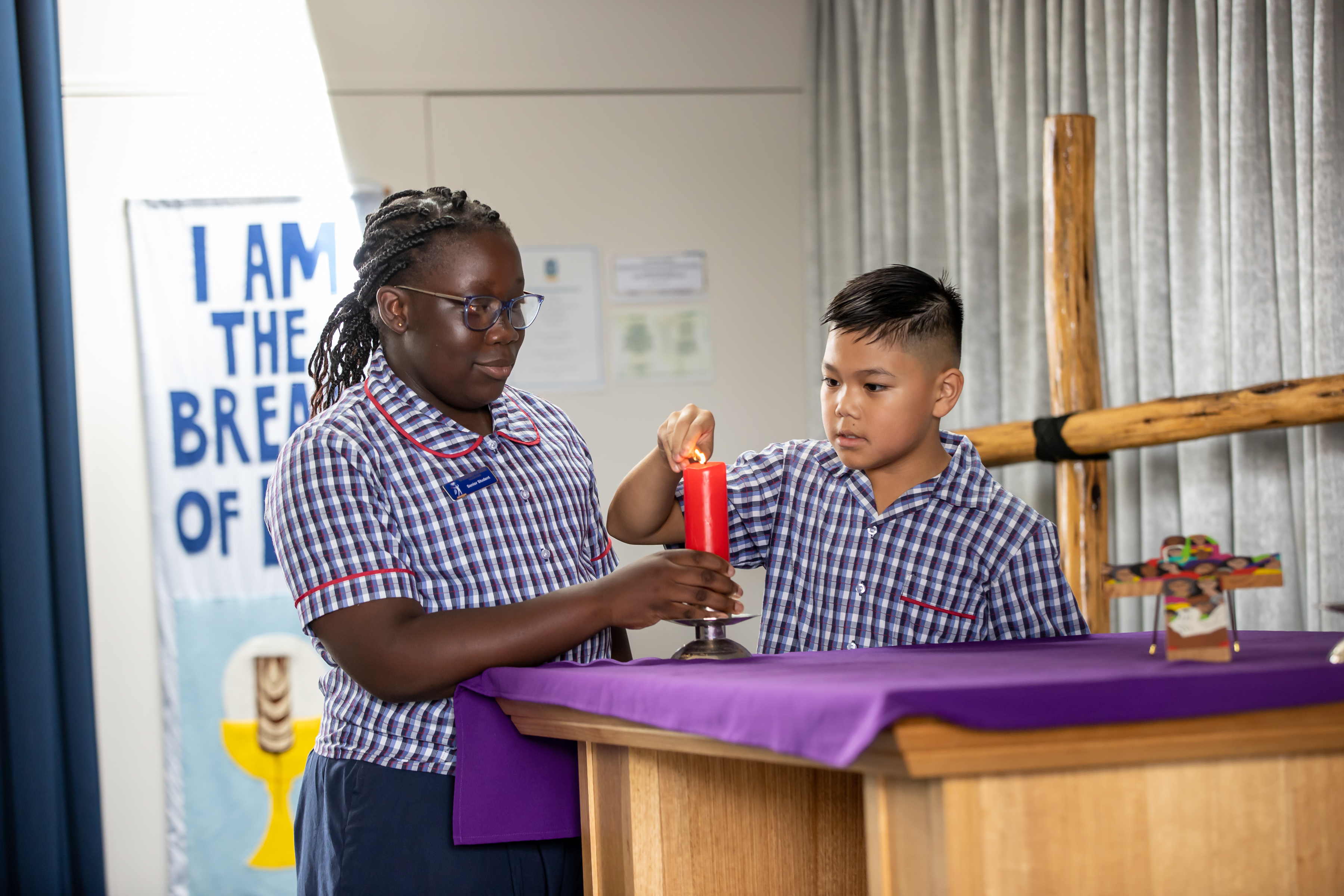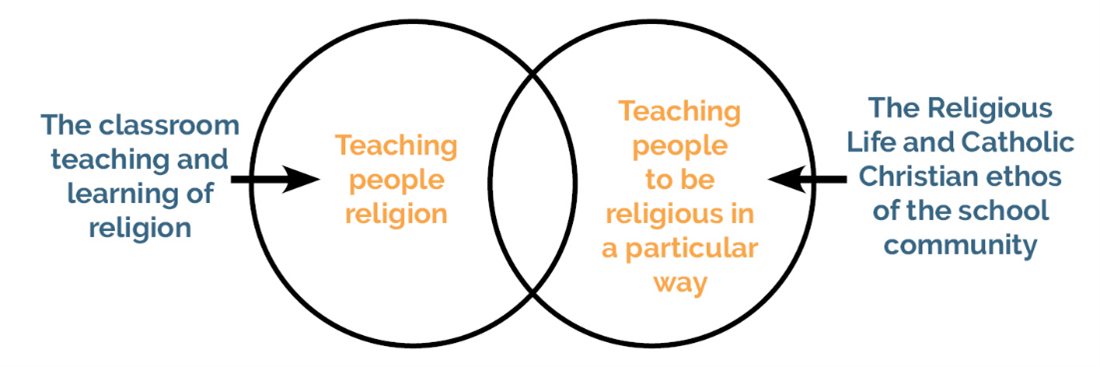Religious Education
The content of the Religion Curriculum P-12 is organised into four interrelated strands: Sacred texts, Beliefs, Church and Christian life. Each strand has its own distinctive body of knowledge.
strand has its own distinctive body of knowledge.
The classroom learning and teaching of religion in the Archdiocese of Brisbane has been characterised by a re-conceptualist approach. It operates from an educational framework and Brisbane Catholic Education's Model for Religious Education. Classroom religion becomes a place for dealing with the critical religious issues and concerns of life.

Model for Religious Education
English
The study of English is central to the learning and development of all young Australians. It helps create confident communicators, imaginative thinkers and informed citizens. It is through the study of English that individuals learn to analyse, understand, communicate and build relationships with others and with the world around them. The study of English plays a key role in the development of reading and literacy skills which help young people develop the knowledge and skills needed for education, training and the workplace. It helps them become ethical, thoughtful, informed and active members of society.
The Australian Curriculum is organised into three interrelated strands that support students' growing understanding and use of Standard Australian English (English). Each strand interacts with and enriches the other strands in creative and flexible ways, the fabric of the curriculum being strengthened by the threads within each sub-strand.
Together, the three strands form an integrating framework of disciplinary knowledge and focus on developing students' knowledge, understanding and skills in listening, reading, viewing, speaking and writing from Prep to Year 6. The three strands are:
Language: knowing about the English language
Literature: understanding, appreciating, responding to, analysing and creating literary texts
Literacy: expanding the repertoire of English usage.
Mathematics
Learning Mathematics creates opportunities for and enriches the lives of all Australians. The Australian Curriculum: Mathematics provides students with essential mathematical skills and knowledge in number and algebra, measurement and geometry, and statistics and probability. It develops the numeracy capabilities that all students need in their personal, work and civic life, and provides the fundamentals on which mathematical specialties and professional applications of mathematics are built.
The Australian Curriculum: Mathematics ensures that the links between the various components of mathematics, as well as the relationship between mathematics and other disciplines, are made clear. Mathematics is composed of multiple but interrelated and interdependent concepts and systems which students apply beyond the mathematics classroom.
The curriculum anticipates that schools will ensure all students benefit from access to the power of mathematical reasoning and learn to apply their mathematical understanding creatively and efficiently. The Mathematics curriculum provides students with carefully paced, in-depth study of critical skills and concepts. It encourages teachers to help students become self-motivated, confident learners through inquiry and active participation in challenging and engaging experiences.
Science
Science provides an empirical way of answering interesting and important questions about the biological, physical and technological world. The knowledge it produces has proved to be a reliable basis for action in our personal, social and economic lives. Science is a dynamic, collaborative and creative human endeavour arising from our desire to make sense of our world through exploring the unknown, investigating universal mysteries, making predictions and solving problems. Science aims to understand a large number of observations in terms of a much smaller number of broad principles. The Australian Curriculum: Science provides opportunities for students to develop an understanding of important science concepts and processes, the practices used to develop scientific knowledge, of science's contribution to our culture and society, and its applications in our lives. The curriculum supports students to develop the scientific knowledge, understandings and skills to make informed decisions about local, national and global issues.
HASS (Humanities and Social Science)
In a world that is increasingly culturally diverse and dynamically interconnected, it is important that students come to understand their world, past and present, and develop a capacity to respond to challenges, now and in the future, in innovative, informed, personal and collective ways. The Australian Curriculum for the Humanities and Social Sciences plays an important role in harnessing students' curiosity and imagination about the world they live in and empowers them to actively shape their lives; make reflective, informed decisions; value their belonging in a diverse and dynamic society; and positively contribute locally, nationally, regionally and globally.
Thinking about and responding to issues requires an understanding of different perspectives; the key historical, geographical, political, economic and societal factors involved; and how these different factors interrelate. The Humanities and Social Sciences in F–6 which encompasses the knowledge and understandings of history, geography, civics and citizenship, and economics and business, gives students a deep understanding of the world they live in from a range of perspectives, past and present, and encourages them to develop an appreciation and respect for social, cultural and religious diversity.
Health and Physical Education (HPE)
In Health and Physical Education, students develop the skills, knowledge, and understanding to strengthen their sense of self, and build and manage satisfying, respectful relationships. They learn to build on personal and community strengths and assets to enhance safety and wellbeing. They critique and challenge assumptions and stereotypes. Students learn to navigate a range of health-related sources, services and organisations.
At the core of Health and Physical Education is the acquisition of movement skills and concepts to enable students to participate in a range of physical activities – confidently, competently and creatively. As a foundation for lifelong physical activity participation and enhanced performance, students acquire an understanding of how the body moves and develop positive attitudes towards physical activity participation. They develop an appreciation of the significance of physical activity, outdoor recreation and sport in Australian society and globally. Movement is a powerful medium for learning, through which students can practise and refine personal, behavioural, social and cognitive skills.
The Arts
In the Australian Curriculum, The Arts is a learning area that draws together related but distinct art forms. While these art forms have close relationships and are often used in interrelated ways, each involves different approaches to arts practices and critical and creative thinking that reflect distinct bodies of knowledge, understanding and skills. The curriculum examines past, current and emerging arts practices in each art form across a range of cultures and places.
The Australian Curriculum: The Arts comprises five subjects:
Dance
Drama
Media Arts
Music
Visual Arts
Technologies
The Australian Curriculum: Technologies describes two distinct but related subjects:
Design and Technologies, in which students use design thinking and technologies to generate and produce designed solutions for authentic needs and opportunities
Digital Technologies, in which students use computational thinking and information systems to define, design and implement digital solutions.
LOTE (Spanish)
The Australian Curriculum: Languages is designed to enable all students to engage in learning a language in addition to English. The design of the Australian Curriculum: Languages recognises the features that languages share as well as the distinctiveness of specific languages.
At St Stephen's School, the Language Other Than English (LOTE) taught is Spanish. Spanish is taught by a Specialist teacher to all year levels from Prep to Year 6.
© Brisbane Catholic Education, St Stephen's School, 2023